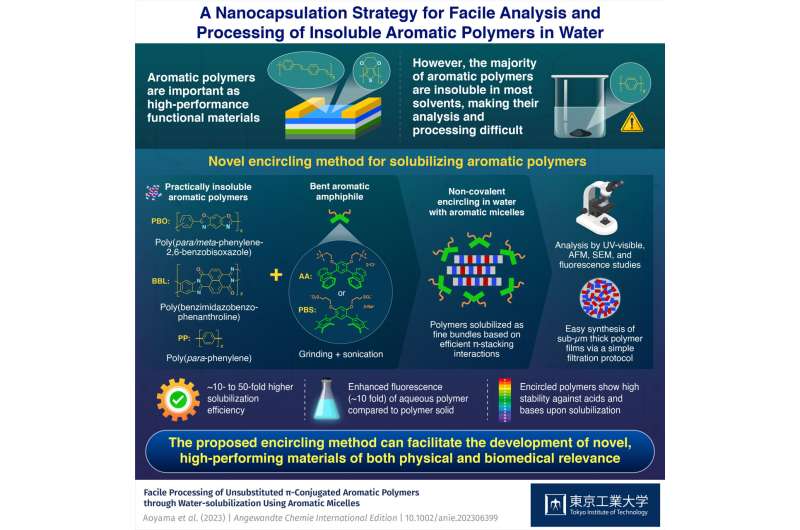This article has been reviewed according to Science X's editorial process and policies. Editors have highlighted the following attributes while ensuring the content's credibility:
fact-checked
peer-reviewed publication
trusted source
proofread
A nanocapsulation strategy for facile analysis and processing of insoluble aromatic polymers in water

Polymeric materials are essential for our everyday lives. In the search for new functional materials, scientists have placed focus on polymers composed of rigid aromatic frameworks, displaying unique electronical/optical properties, heat resistance and mechanical advantages.
However, due to their high rigidity and strong self-aggregation, aromatic polymers are insoluble in organic solvents and water, which hampers their processing and further development. Current solubilization methods mainy rely on laborious and costly installation of side-chains onto the polymer backbone, furthermore resulting in undesired property changes.
To address this issue, scientists from Tokyo Tech's Laboratory for Chemistry and Life Science in Japan studied the water-solubilization of such hard-to-handle, insoluble aromatic polymers utilizing so-called bent aromatic amphiphiles (i.e., surfactants).
Published in Angewandte Chemie, Shinji Aoyama, Lorenzo Catti, and Michito Yoshizawa demonstrate that anthracene-based amphiphile—AA—and its pentamethylbenzene derivative—PBS—developed in their laboratory, are capable of solubilizing various insoluble aromatic polymers in water with high efficiency through encircling.
AA and PBS are representatives of a new class of amphiphiles, consisting of a hydrophobic bent aromatic framework featuring two hydrophilic side-chains. In water, these aromatic amphiphiles form micelle-like nanocapsules that can encapsulate a wide variety of hydrophobic molecules.
For the water-solubilization, the polymer and aromatic amphiphile were subjected to a simple grinding-sonication protocol. UV-visible analysis of the obtained clear aqueous solutions clearly showed new absorption bands derived from the solubilized polymers.
The high generality of the the methodology allowed solubilization of several polymers, including poly(para-phenylene-2,6-benzobisoxazole)) (PBO; Zylon), poly(benzimidazobenzophenanthroline) (BBL) and notoriously insoluble poly(para-phenylene) (PP). Under the same conditions, the water solubilization efficiency was found to be more than 50 times higher than that with coventional amphiphiles (SDS and DTAC).
"Besides efficient water-solubilization, we were surprised to find that the resultant PP solution exhibits unprecedented strong bluish fluorescence (30% quantum yield (FF)). While PP shows only weak fluorescence in the solid state, the fluorescence could be increased by a factor of ~10 using our nanocapsulation strategy", says Dr. Catti.
Structural analysis of the solubilized polymers was conducted via atomic force microscopy (AFM). The obtained data, in combination with molecular modeling studies, indicated solubilization of the polymers as small bundles (~1 nm in thickness) encircled by the aromatic amphiphiles.
Importantly, aqueous processing of the solubilized polymers into thin films was achieved through a simple filtration protocol. The obtained sub-micrometer thick films were shown to consist of a compact network of tightly entangled polymer fibers, as evidenced by scanning electron microscopy (SEM). Filtration of mixed polymer solutions furthermore provided access to multicomponent polymer films (e.g., PBO-BBL). The recovered amphiphiles were fully reusable, further contributing to the sustainability of the methodology.
The team concludes, "While the focus of this study was placed on 1D polymers, we are convinced that the generality of the method will allow us to process of a wide range of 2D and 3D polymers in the future. Doping and processing of these polymers is expected to contribute to the development of unprecedented aromatic materials."
More information: Shinji Aoyama et al, Facile Processing of Unsubstituted π‐Conjugated Aromatic Polymers through Water‐solubilization Using Aromatic Micelles, Angewandte Chemie International Edition (2023). DOI: 10.1002/anie.202306399
Journal information: Angewandte Chemie International Edition , Angewandte Chemie
Provided by Tokyo Institute of Technology





















